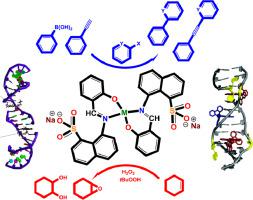Journal of the Taiwan Institute of Chemical Engineers ( IF 5.5 ) Pub Date : 2021-01-19 , DOI: 10.1016/j.jtice.2021.01.015 Mohamed Shaker S. Adam , M.M. Makhlouf , Farman Ullah , Ahmad Desoky M. Mohamad

|
Two novel water-soluble mononuclear Cu(II) and VO(II)-complexes (CuSL and VOSL, respectively) were synthesized from easily accessible 2-((naphthalen-1-ylimino)methyl)phenolate sodium sulfonate as a Schiff base ligand (HSL). HSL, CuSL and VOSL were characterized by various spectral tools. Their catalytic potential was investigated and compared in 1,2-cyclohexene epoxidation using H2O2 or tBuOOH as an oxidizing agent, and in C―C cross-coupling protocols, including Suzuki-Miyaura and Sonogashira reactions, under homogeneous reaction conditions. Both complexes exhibited good catalytic potential in the epoxidation reaction. VOSL complex with the high oxidation state metal ion (VIV) exhibited slightly better performance in the epoxidation reaction, provided 93, 77 and 89% yield in acetonitrile, water and under solvent free condition. In contrast CuSL complex provided 89, 71 and 79% yield under the same reaction condition. While in Suzuki-Miyaura and Sonogashira C―C reactions using phenylboronic acid or phenylacetylene with aryl halides, CuSL afforded better catalytic potential (89% for Suzuki-Miyaura and 77% yield for Sonogashira C―C products) than VOSL catalyst (73% and 51% yield respectively). DFT studies were also carried to understand the catalytic behavior of CuSL and VOSL catalysts in their catalytic processes. Additionally HSL, CuSL and VOSL were also explored for their biological potential against some pathogens strains, as antimicrobial, antioxidant and anticancer agents. Both complexes (CuSL and VOSL) showed better inhibiting potential than their free ligand. The complex ctDNA-interaction was examined by UV–vis. spectrophotometry, viscosity measurements and gel electrophoresis to determine the nature of binding. Additionally, molecular docking was also carried out for better understanding.
中文翻译:

萘二亚氨基苯酚磺酸钠的单核铜(II)和钒基(II)配合物的催化和生物反应性
从容易获得的2-((萘-1-基氨基)甲基)苯酚磺酸钠作为席夫碱配体合成了两种新颖的水溶性单核Cu(II)和VO(II)-络合物(分别为CuSL和VOSL)( HSL)。HSL,CuSL和VOSL由各种光谱工具表征。在均相反应条件下,在以H 2 O 2或t BuOOH为氧化剂的1,2-环己烯环氧化反应中,以及在S–C交叉偶联方案(包括Suzuki-Miyaura和Sonogashira反应)中,研究了它们的催化潜力。两种络合物在环氧化反应中均显示出良好的催化潜力。VOSL与高氧化态金属离子(V IV)在环氧化反应中表现出稍好一些的性能,在乙腈,水和无溶剂条件下的收率分别为93、77和89%。相反,在相同的反应条件下,CuSL复合物的收率分别为89%,71%和79%。在使用苯基硼酸或苯乙炔与芳基卤化物的Suzuki-Miyaura和Sonogashira C-C反应中,CuSL的催化潜力(Suzuki-Miyaura的为89%,Sonogashira C-C的产率为77%)比VOSL催化剂(73%和分别为51%的收率)。还进行了DFT研究,以了解CuSL和VOSL催化剂在其催化过程中的催化行为。此外,还对HSL,CuSL和VOSL的抗微生物,抗氧化剂和抗癌药的生物潜力进行了研究。两种复合物(CuSL和VOSL)均显示出比其游离配体更好的抑制潜力。复杂ct DNA相互作用通过紫外可见检验。分光光度法,粘度测量和凝胶电泳以确定结合的性质。另外,还进行了分子对接以更好地理解。











































 京公网安备 11010802027423号
京公网安备 11010802027423号